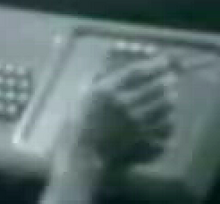This is an old revision of this page, as edited by Sigma 7 (talk | contribs) at 04:32, 25 December 2007 (Undid revision 179961915 by 81.215.70.149 (talk)). The present address (URL) is a permanent link to this revision, which may differ significantly from the current revision.
Revision as of 04:32, 25 December 2007 by Sigma 7 (talk | contribs) (Undid revision 179961915 by 81.215.70.149 (talk))(diff) ← Previous revision | Latest revision (diff) | Newer revision → (diff)A mousepad (sometimes mouse pad, mousemat, or mouse mat), is a surface for enhancing the usability of a computer mouse.
History

During a 1968 presentation by Douglas Engelbart marking the public debut of a mouse, Engelbart used a control console designed by Jack Kelley of Herman Miller that included a keyboard and an inset portion used as a support area for the mouse.
According to Kelley and also stated by Alex Pang, Kelley designed the first mousepad a year later, in 1969.
Details of a mousepad designed by Armando M. Fernandez were published in the Xerox Disclosure Journal in 1979 with the description:
CRT CURSER CONTROL MECHANISM PAD
— Xerox Disclosure Journal, Volume 4, Number 6, November/December 1979
To assist the operation of a cathode ray tube pointer 10 wherein a metal ball is rolled on a hard surface, the disclosed pad may be utilized. A resilient, rubber-like material 12 is bonded or otherwise attached to a hard base material 14 which keeps the rubber-like material flat. The base has four rubber-like pads 16 on the opposite side from the resilient material to refrain the pad from sliding on the surface of a table, for instance.
By 1982, most users of the Xerox ball mouse were using mousepads.
The Oxford English Dictionary tracks the term mouse pad to the 25 August, 1983, publication of InfoWorld, and the predominantly British term mousemat to 17 October, 1989, in the publication 3D.
Benefits
The three most important benefits of the introduction of the mousepad were higher speed, more precision, and comfort for the user. A secondary benefit was keeping the desk or table surface from being scratched and worn by continuous hand and mouse rubbing motion. Another benefit was reduction of the collection of debris under the mouse, which resulted in reduced jitter of the pointer on the display.
When optical mice, which use image sensors to detect movement, were first introduced into the market, they required special mousepads with optical patterns printed on them. Modern optical mice can function to an acceptable degree of accuracy on plain paper and other surfaces. However, some optical mouse users may prefer a mousepad for comfort, speed and accuracy, and to prevent wear to the desk or table surface.
Types
A variety of mousepads exist with many different textured surfaces to fit various different types of mouse technologies. Vinyl board cover, because of its tackiness, was a popular mousepad surface around 1980.
After the rubberized silicon surface was incorporated onto the surface of the steel roller ball mouse, the popular fabric-surface mousepad was found to be the most appropriate. It helped keep the rubberized roller-ball surface cleaner and with better tracking, speed and accuracy than just a desk surface, which collected dirt and slowed the mouse's motion.
Optical mice have the problem of not working well on transparent or reflective surfaces (such as glass or highly polished wood). These surfaces, which often include desk and table surfaces, cause jitter and loss of tracking on the display pointer as the mouse moves over these reflective spots. The use of mousepads with precision surfaces eliminates spot jitter effects of modern optical mice.
Designs

Originally, mousepads were available in a simple rectangular shape. In recent years, though, they have been available in many shapes and designs. Ergonomic designs are available with built-in wrist rests made of silicone gel, foamed and beaded materials.
Companies often give away mousepads for promotional reasons, and computer manufacturers often include a mousepad with their logo on it, usually with technical support information. Many artists have published work on mousepads.
There is now a fairly large variety of high quality "gaming grade" mousepads. In the beginning there were only a few such manufacturers: Everglide (arguably the first to come onto the market), fUnc Industries, Icemat, SteelSeries and Ratpadz (made by ard|OCP). In 2005, several more companies followed suit, including Razer, Qpad, Corepad, Xtracpads, X-Ray, Gamerzstuff, Ideazon, and Allsop. These pads are available in a wide variety of sizes to suit the different sensitivity settings that gamers choose. The Corepad Deskpad XXXL, one of the largest pads on the market, measures 90cm x 45cm.
Materials
Modern mousepads are typically made of foam rubber with fabric bonded to the upper surface. However, many other types of material have been used, including fabric, plastics, recycled rubber tires, silicone rubber, leather, glass, cork, wood, aluminum, stone and stainless steel. High-quality gaming mats are usually made from plastic or high-tech fibers.
References
- ^ "The Demo (article on Engelbart's demo)". Retrieved 2007-02-26., final video
- "Doug Engelbart: The Demo (movie)". Retrieved 2007-02-26., time: 1:12:35
- "Jack Kelley (Herman Miller page)". Retrieved 2007-02-26.
- Alex Soojung-Kin Pang. "The Making of the Mouse". Retrieved 2007-02-26.
- "CRT Curser Control Mechanism Pad". Xerox Disclosure Journal. Nov/Dec 1979. Retrieved 2007-02-26.
{{cite web}}: Check date values in:|date=(help) - Richard F. Lyon and Martin P. Haeberli (1982). "Designing and Testing the Optical Mouse" (PDF). VLSI Design (Jan./Feb.): 21.
- Oxford English Dictionary Online, "mouse", compounds 20. d.
- Corepad Victory & Deskpad XXXL product review